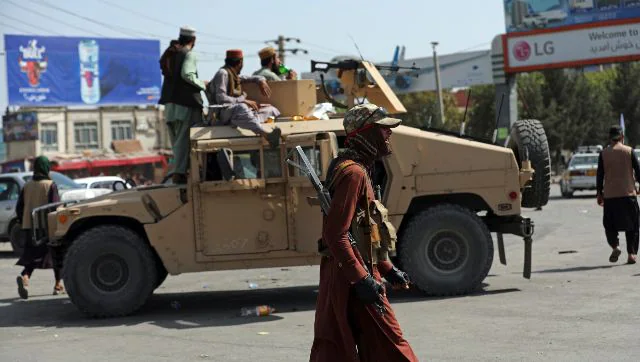Taliban, ISIS, Al Qaeda, Haqqanis are heads of the same monster in Pakistan’s zoo of terror
[ad_1]
Jihadi groups across the world are cut from the same ideological cloth. But in Afghanistan, the deep bonds go beyond ideology
Members of the Taliban. AP
Afghanistan is now a fresh carcass for many predators and scavengers to feast on. The main terror groups are the Taliban, Islamic State (Khorasan), Al Qaeda and the Haqqani network.
After the latest bombings near the Kabul airport in which more than 160 people were killed including several US soldiers, which Islamic State claimed responsibility, a section of the international media and a part of the American security establishment have sought to underplay the Taliban’s role.
It is understandable that those in the White House responsible for America’s hasty and messy withdrawal, handing over a nation for slaughter at the hands of what they described as a “changed Taliban eager to seek legitimacy”, will try to salvage shreds of Taliban’s image to justify their own colossal cowardice. The liberal media, forever ready to give covering fire to Islamist terrorism so that Muslims do not face tough questions about their faith and community, is also subtly trying to isolate the Taliban by blaming the ongoing carnival of crimes against humanity in Afghanistan entirely on ISIS. It is their last fig leaf.
But the reality is different.
Jihadi groups across the world are cut from the same ideological cloth. But in Afghanistan, the deep bonds go beyond ideology.
Many jihadis of IS-K come from the Taliban itself after its founder Mullah Omar died a few years ago. They have no ideological differences. One day they fight with each other, another day they cooperate and carry out mayhem.
Who released thousands of IS terrorists from prisons recently? The Taliban.
How did ISIS jihadis reach near the airport area to carry out the bombings while the Taliban stopped all other local groups and forces at checkpoints? The Taliban obviously knew or even coordinated the attacks.
After the US’s retaliatory drone strike that killed a high-value IS target, a Taliban spokesperson promptly condemned it as a “clear attack on Afghan territory”.
The fact is, both the Taliban and IS comprise Afghan and Pakistani jihadis. And every terror group in the region including the Haqqani network and Al Qaeda derive the blessing, funding, training and motivation to kill and destroy from the invisible force that America and others have refused to take on: Pakistan’s jihad-military complex and its intelligence agency, the IS.
Events on the ground easily reveal a sinister pattern.
A Sikh gurdwara was attacked by suicide bombers and gunmen in Kabul on 25 March, 2020. The terror onslaught left 25 dead. ISIS-K claimed responsibility.
A counterterrorism operation in Kandahar netted Aslam Farooqi (or Abdullah Orakzai), the Pakistani leader of ISIS-K. Farooqi said ISIS had coordinated the attack with the Haqqani network. But he revealed something even grimmer. Besides the Haqqanis, the ISIS had also teamed up with Pakistani Jaish-e-Mohammed (JeM) and the Lashkar-e-Toiba (LeT), which Farooqi was once part of.
Jaish and Lashkar have been created and supported by the ISI to carry out terror attacks on India. The LeT executed the 2008 Mumbai terror attacks, for instance, while Jaish was behind the 2019 Pulwama attack that killed scores of Indian troops.
The many groups like the Taliban, IS, Haqqanis, Al Qaeda. LeT, Jaish are interlinked tentacles of the same Islamist terrorism ecosystem of Pakistan and Afghanistan.
Recruits of ISIS-K, which is mainly based in the Nangarhar province of Afghanistan on the Pak border, get training at JeM camps in Pakistan. They are into the narcotics and human trafficking trade and control some front companies like car dealerships.
The LeT carries out reconnaissance on targets in Afghanistan. The Haqqani network, through their narco and other crime syndicates, provides coordination and logistical planning. ISIS-K often provides the suicide bombers and other disposables in the unending holy war, while the Taliban now wants to project a legitimised, diplomatic face.
To try and de-hyphenate them is disingenuous and farcical.
On 12 May, 2020, ISIS-K gunmen stormed the maternity ward of the Dasht-e-Barchi hospital in Kabul. They indiscriminately killed hospital staff, women in labor, and newborn babies. The US Special Representative for Afghanistan Reconciliation, Zalmay Khalilzad, blamed ISIS but skirted the Taliban. Afghanistan was shocked. It seemed Khalilzad was more concerned about preserving the Taliban’s image to maintain the so-called “peace talks”.
It is this hypocrisy that has turned the entire region into a cauldron of fire. It is time the world addresses the elephant in the room: that Islamist terrorism is one creature with many faces, and in this region, is it sustained by Pakistan and its many violent puppets.
[ad_2]
Source link


Comments are closed.